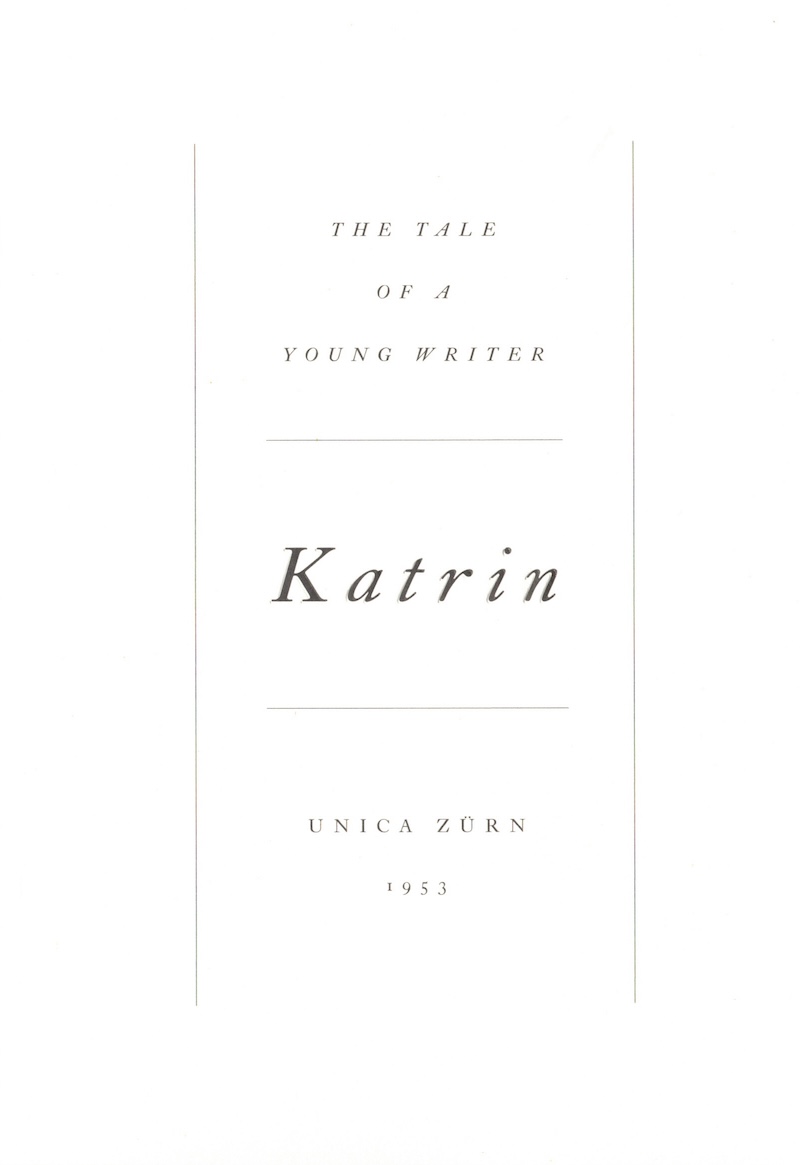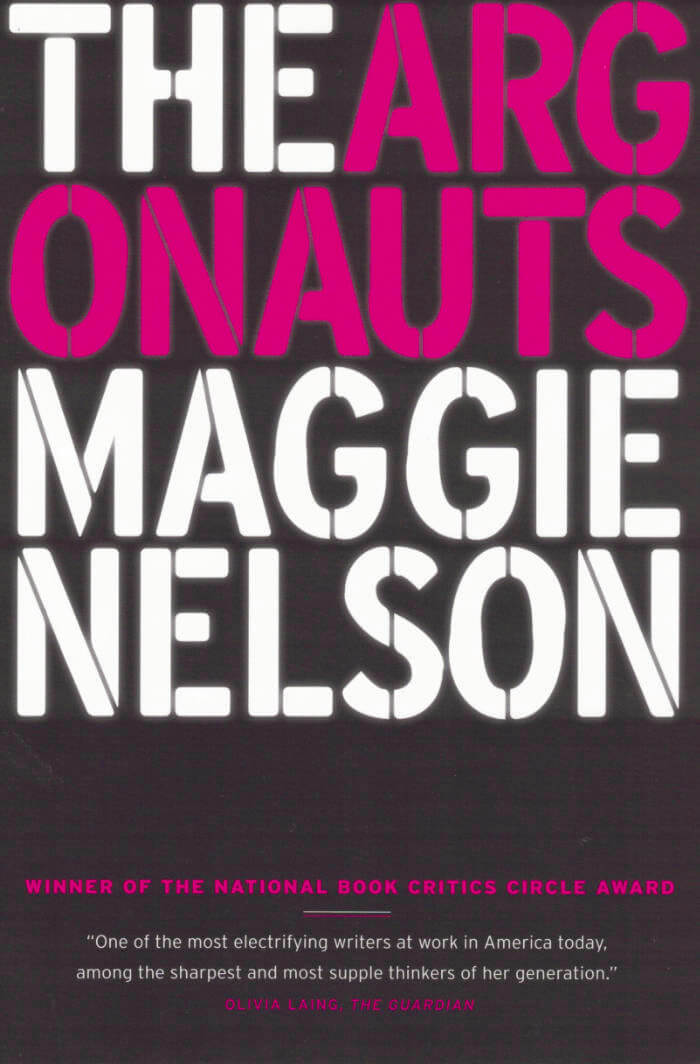Autofiction
Autofiction

Katrin – The Tale of a Young Writer
Unica Zürn, Louis Bazalgette Zanetti
A partly autobiographical novel that the German surrealist artist and author Unica Zürn (1916-1970) wrote for her ten-year-old daughter in 1953, although it would never be published in her lifetime. This is the first translation of the tale from German into English.
Unica Zürn tells the story of fifteen-year-old motherless Katrin, an aspiring writer, who lives with her father, also a writer. The novel is set in an imaginary world, a metropolis called Linit, split into three levels: Oberstadt (Hightown), Mittelstadt (Middletown) and Unterstadt (Lowtown), overlooked by a Volcano where the artists live and crossed by the river Emil. Presented as a book for children, apparently written for her own daughter (named Katrin), Katrin also draws on the personal biography of Zürn herself, in terms of her relationship with her father and the city of Berlin after WWII, and her experience with people on the margins of a society characterised by great tensions.
About Unica Zürn
Nora Berta "Unika" Ruth Zürn, originally known as Ruth, was born on 6 July 1916 in Berlin. Raised in Berlin, Zürn had a contentious relationship with her mother, while she idolized her absent father. While at school she published her first short stories in magazines for young people, and in 1933 she began to work at the UFA film studios in Berlin (acronym for Universum-Film Aktiengesellschaft, a major German film company producing and distributing motion pictures from 1917 until the end of the Nazi era). In 1942 she married and had two children, Katrin and Christian. Shortly after, she lost the custody of her children. For the next few years she survived by writing short stories for newspapers and radio plays. After the war, she became part of the Bohemian group of Berlin and began to call herself Unika (after her aunt Unika Pudor). She frequented the artistic milieu revolving around the DADA-surrealist cabaret Die Badewanne ("The Bathtub"). In 1953, Zürn met the artist Hans Bellmer, best known for his disassembled dolls in unconventional poses directed at the cult of the perfect body then prominent in Germany, and became his muse. They lived together in Paris for many years, albeit in a conflictual relationship. Zürn concentrated on producing poetic anagrams supplemented by drawings, thus developing her own multidimensional surreal style. From the late 1950s, she suffered from forms of anxiety, later diagnosed as schizophrenia, and produced a wealth of remarkable textual and visual material while in psychiatric institutions across Germany and France. From 1956 to 1964, Zürn had four solo exhibitions of her drawings, and her work was included in the Exposition Internationale du Surréalisme. The exploration of the unconscious dimension would increasingly lose its liberating, positive aspect and turn into a fixation on a narrow space, one in which the self is tormented by distressing visions. Her psychological difficulties inspired much of her writing, especially Der Mann im Jasmin (The Man of Jasmine, published in English in 1971). Other published texts by Zürn include Hexentexte (1954) and Dunkler Frühling (Dark Spring, 1967). Zürn died on 19 October 1970 in Paris, throwing herself from the sixth floor.

Crazy for Vincent
Diary, memoir, poem, fiction? Autopsy, crime scene, hagiography, hymn? The chronicle of an obsessive love. In the middle of the night between the 25th and 26th of November, Vincent fell from the third floor playing parachute with a bathrobe. He drank a liter of tequila, smoked Congolese grass, snorted cocaine...
Crazy for Vincent begins with the death of the figure it fixates upon: Vincent, a skateboarding, drug-addled, delicate "monster" of a boy in whom the narrator finds a most sublime beauty. By turns tender and violent, Vincent drops in and out of French writer and photographer Hervé Guibert's life over the span of six years (from 1982, when he first met Vincent as a fifteen-year-old teenager, to 1988). After Vincent's senseless death, the narrator embarks on a reconnaissance writing mission to retrieve the Vincent that had entered, elevated, and emotionally eviscerated his life, working chronologically backward from the death that opens the text. Assembling Vincent's fragmentary appearances in his journal, the author seeks to understand what Vincent's presence in his life had been: a passion? a love? an erotic obsession? or an authorial invention? A parallel inquiry could be made into the book that results: Is it diary, memoir, poem, fiction? Autopsy, crime scene, hagiography, hymn? Crazy for Vincent is a text the very nature of which is as untethered as desire itself.
Hervé Guibert (1955-1991) was a writer, a photography critic for Le Monde, a photographer, and a filmmaker. In 1984 he and Patrice Chereau were awarded a César for best screenplay for L'Homme Blessé. Shortly before his death from AIDS, he completed La Pudeur ou L'impudeur, a video work that chronicles the last days of his life.

Candles and Water
Candles and Water is a queer pillow book: a document of wreckage, haunting, and survival.
This collection is made of fictions and diaries, dreams and lists, lies and ghost stories. Its fragments and filaments are lonely, joyous, enraged, sickly, and lost; and when they crystallize around a single voice, it is by way of healing from grief and recovery from addiction.
Timothy Thornton is a writer and musician. His work was in Volume 2 of the new Penguin Modern Poets series, and he has published eleven books of poetry with small presses. He organised two series of reading and performance nights in Brighton: 'evenly and perversely' and 'WHAT YOU NEED'. He has composed and performed scores for productions at Battersea Arts Centre and The Yard Theatre.
'Candles and Water risks everything, daring to explore powerful vulnerabilities, yearning, and unabashed hope. Elusiveness and the whisperings of shadows inhabit these pages, always illuminated and burnished by the voice of a poet'. — Thomas Glave, author of Among The Bloodpeople
'Timothy Thornton's Candles and Water is a rare and transformational book, haunting, beautiful and watchful. Writing that follows its brush like Sei Shōnagon.' — David Hayden, author of Darker with the Lights On
'These radical, scattered shards of life and sensation. . . come to a whole, coalescing like bioluminescence. . . witty, dark, profound, devastating. One long séance with a fellow human soul.' — Philip Hoare, author of RISINGTIDEFALLINGSTAR

If You're a Girl: Selected Stories 1985–2023
The trailblazing book that influenced a generation of writers, and proves that mature reflection needn't be lacking in attitude.
In the beginning when everything was very sexual we talked about our fantasies. She thought about having a guy for some of it. She thought about having a gun. I had gone through a lot to get away from guys so I admit that the thought of going back to them, even for a little adventure, was surprising and disconcerting …
Ann Rower's first book, If You're a Girl, published by Semiotext(e)'s Native Agents series in 1991 in tandem with Cookie Mueller's Walking Through Clear Water in a Pool Painted Black, cemented her reputation as the Eve Babitz of lower Manhattan.
Rower was fifty-three years old at the time. Her stories—urtexts of female autofiction—had long been circulating within the poetry and postpunk music scenes. They were unlike anyone else's: disarming, embarrassing, psuedoconfessional tales of everyday life dizzily told and laced with dry humor. In If You're a Girl, she recounts her adventures as Timothy Leary's babysitter, her artistic romance with actor Ron Vawter, and her attempts to evade a schizophrenic stalker.
Rower went on to publish two novels: Armed Response (1995) and Lee & Elaine (2002). After the 2002 suicide of her partner, the writer Heather Lewis, Rower stopped writing for almost two decades. And then she picked up where If You're a Girl left off. No longer a girl, she produced dozens of stories from her life in New York as an octogenarian.
This new, expanded edition includes most of the original book, together with selections from both her novels and her recent writings. If You're a Girl is a trailblazing book that manifests Rower's influence on a generation of writers, and proves that mature reflection needn't be lacking in attitude.
Ann Rower is the author of If You're A Girl, Armed Response, and Lee & Elaine. She received a PhD from Columbia University in sixteenth-century English literature in 1974, and has collaborated with the Wooster Group as a writer. Rower taught writing in New York at the School for Visual Arts between 1974 and 2019.
Introduction by Sheila Heti.

Peter Hujar's Day
On December 18, 1974, the author Linda Rosenkrantz asked her friend Peter Hujar to write down everything he did on that day. Hujar met Rosenkrantz at her apartment on 94th Street the following day, where she asked him about it in detail and tape-recorded their conversation. Peter Hujar's Day is a full transcript of that exchange, published here for the first time since it was recorded 47 years ago. The book features an introduction by Stephen Koch, director of the Peter Hujar Estate.
Linda Rosenkrantz (born 1934) is a Los Angeles-based, Bronx-born writer and the author of the "repellently raunchy" novel Talk (1969, republished as a New York Review Books Classic in 2015), Telegram! (2003), a history of telegraphic communication, and her memoir, My Life as a List: 207 Things About My (Bronx) Childhood (1999). She is the coauthor of Gone Hollywood: The Movie Colony in the Golden Age (1979).

You have within you something stronger and more numinous
'You have within you something stronger and more numinous' by Margarita Maximova is a collection of extracts of letters sent to her by her mother over the course of ten years.

The Argonauts
Maggie Nelson's The Argonauts is a genre-bending memoir, a work of autotheory offering fresh, fierce, and timely thinking about desire, identity, and the limitations and possibilities of love and language. It binds an account of Nelson's relationship with her partner and a journey to and through a pregnancy to a rigorous exploration of sexuality, gender, and family. An insistence on radical individual freedom and the value of caretaking becomes the rallying cry for this thoughtful, unabashed, uncompromising book.